Cold-process shampoo bars are easy to make at a low cost and have amazing benefits for your hair. Made with nourishing ingredients and pure essential oils, these shampoo bars are the perfect all-natural solution.
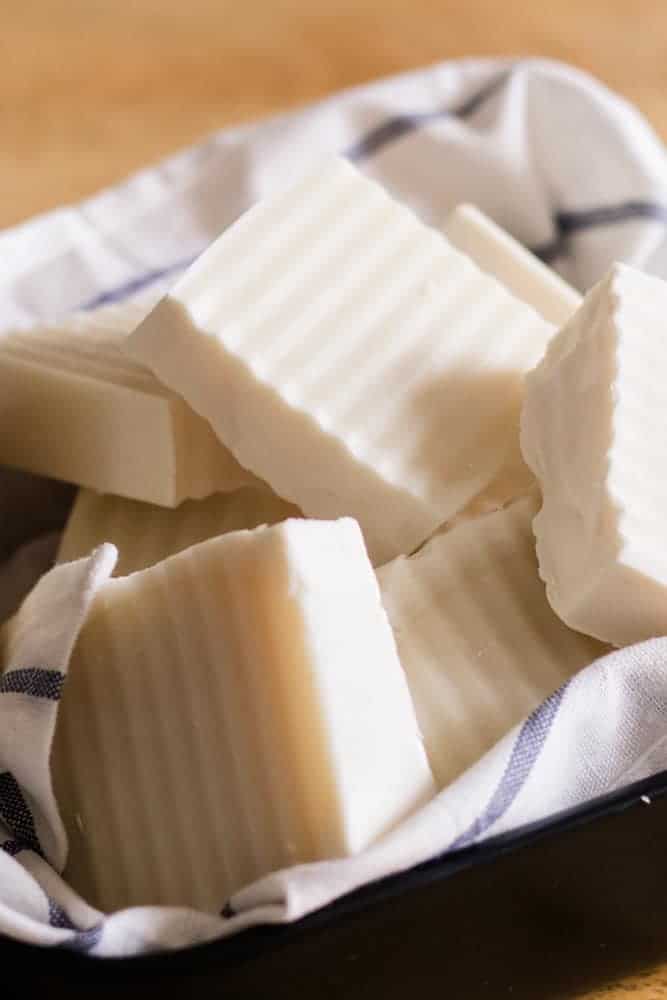
It seems as if most people are switching to more natural hair care and skin care routines these days. Homemade shampoo, “no-poo,” and shampoo bars are all the rave these days.
It may take a little bit for your hair to adjust to natural products, but once it does, you will never go back. Making your own shampoo will save you a lot of money over time and is better for your health.
With a few simple ingredients, you will be able to whip up your own shampoo bar that lathers, cleanses and helps with hair growth.
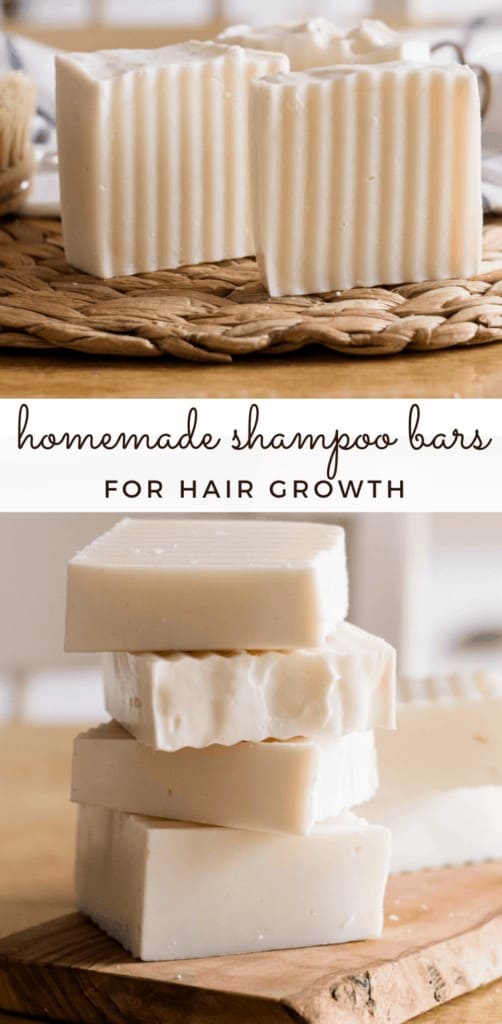
DIY SHAMPOO BARS
If you are not much of a soap maker or DIYer, you can make a melt and pour shampoo bar. Though they work great, you can’t customize them as much as cold-process bars.
Plus, making soap from scratch is cheaper than using a melt and pour soap base. I actually started with melt and pour bases, frankly, because I was hesitant to mess with lye.
Lye is the ingredient needed to make all soap and can be dangerous if handled incorrectly.
HOW TO MAKE LYE SOAP SAFELY
When mixing the lye into the water, avoid breathing in the fumes. Always work in a well-ventilated room, or even better, outside.
Wear safety goggles, gloves, and long sleeves as lye can be very dangerous if it gets in the eyes or on the skin. Don’t worry, once the lye is mixed with the fats, it is not dangerous anymore. Remember, lye is in all soap, so it isn’t as scary as it sounds.
Before whipping up a batch of cold-process soap, be sure to have a spray bottle of vinegar nearby as vinegar can neutralize the lye.
WHY MAKE SOLID SHAMPOO BARS?
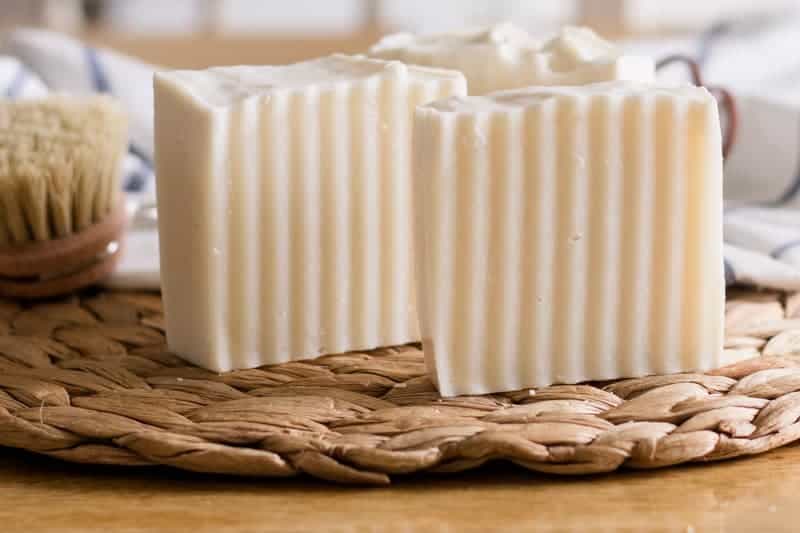
Solid shampoo is the way to go if you are a traveler. It makes it much easier to get through airport security and you don’t have to worry about spilling any liquid.
Solid shampoo bars are easy to customize, cost-effective, and take up very little space. They lather up well and are easy to use.
WHICH FATS ARE BEST FOR HOMEMADE SHAMPOO BARS?
When making any soap bar, you will need fat. Tallow, shea butter, cocoa butter, coconut oil, olive oil, and castor oil are some of the most popular choices.
Tallow soap bars are amazing for the skin and coconut bars are very moisturizing; when choosing a fat for your homemade shampoo bar, you will want to choose according to your hair type.
Tallow
High in vitamins A, D, K, and E, moisturizing, and makes a long-lasting shampoo bar.
Best for dry, frizzy hair
Coconut Oil
Promotes hair growth, hydrates scalp and hair, anti-fungal, anti-bacterial, and anti-inflammatory.
Best for dry, thinning hair
Olive Oil
Contains antioxidants, anti-inflammatory properties, anti-bacterial properties
Best for dull hair
Castor Oil
Stimulates hair follicles, hydrates hair and scalp, and contains vitamin E and fatty acids
Best for thinning hair and split ends
Avocado Oil
High in oleic acid, contains vitamin E, rich in antioxidants
Best for damaged and dry hair
Mango Butter
Rich in vitamin A, E, and mangiferin, very hydrating
Best for dry hair and can help with dandruff
Cocoa Butter
Moisturizing and conditioning, provides shine, protects against split ends, and softens hair.
Best for dull hair with split ends
Shea Butter
High in vitamins A and E along with essential fatty acids
Best for frizzy hair
HOW TO MAKE COLD-PROCESS SHAMPOO BARS
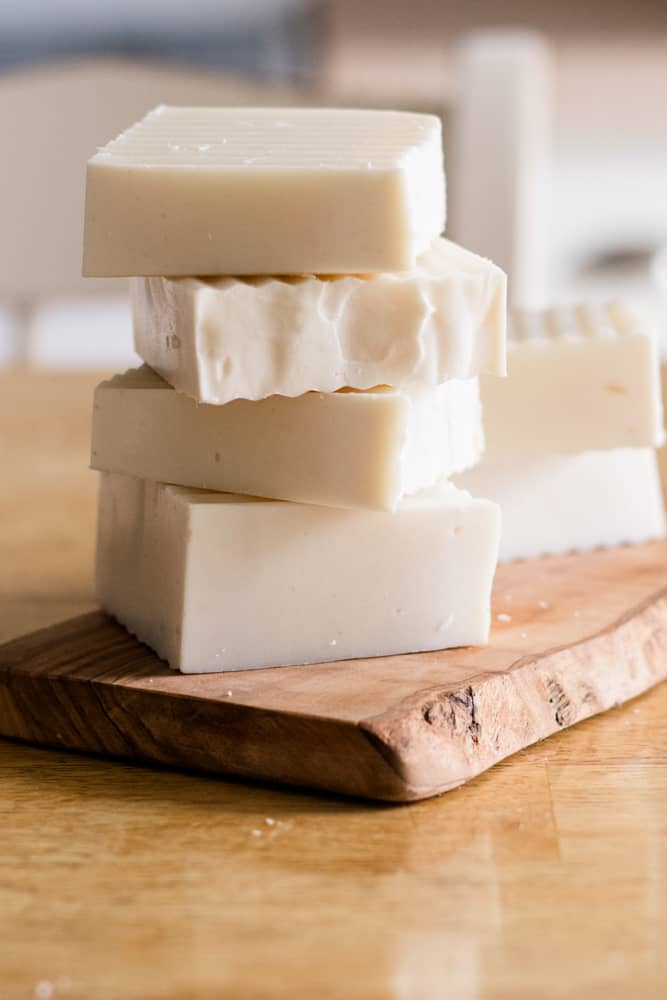
I am using tallow, olive oil, shea butter, and castor oil for my shampoo bar. This blend works great for most hair types and will help to strengthen damaged hair and hydrate dry hair.
I used a soap calculator to get the exact measurements. If you want to change up the recipe at all, you will need to get new measurements to make sure your shampoo bar comes out right and use the correct lye-water mixture.
This post contains affiliate links, which means I make a small commission at no extra cost to you. Get my full disclosure HERE.
SUPPLIES NEEDED:
- Thick glass bowl or jar, make sure it is heat resistant
- Safety goggles
- Rubber gloves
- Immersion blender
- Digital Scale
- Soap molds
INGREDIENTS NEEDED:
- 10 ounces tallow
- 8 ounces olive oil
- 8 ounces shea butter
- 8 ounces castor oil
- 4.41 ounces lye
- 9.86 ounces distilled water
- 15-20 drops essential oils, optional
STEP BY STEP PROCESS:
- Using a digital scale, measure out your water and pour it into a heat-resistant glass bowl or jar.
- Measure out the lye and add it to the water. Stir the lye into the water slowly and stir until it dissolves. NEVER add water to the lye, only lye to water.
- Using the digital scale, measure out the tallow, olive oil, shea butter, and castor oil. Pour into a saucepan and melt over medium heat.
- Once the ingredients are melted, allow them to cool back down to 100 degrees.
- Once the fats cool to 100 degrees, it is time to mix the lye water with the oils. Slowly add the lye and water to the oils, mix with an immersion blender. This will take a couple of minutes. You will know it is the right consistency when the soap from the blender drips and pools up at the top of the soap in the saucepan. This is known as the trace.
- If using essential oils, add those in now. Stir well.
- Pour the soap into the soap molds. If using silicone soap molds, you don’t have to do any prep before pouring it in. Other molds may require parchment paper.
- Allow the soap to harden in the molds for at least 24 hours or up to 3 days.
- Remove the soap from the molds and allow it to cure for 3-4 weeks before using.
ESSENTIAL OIL SHAMPOO BAR
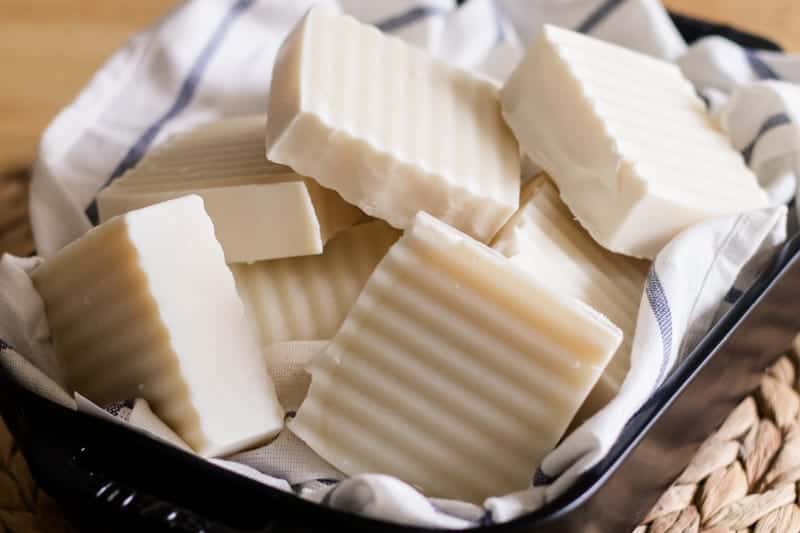
As mentioned above, you can add essential oils to your shampoo bar. The essential oils will customize your soap even more and give your bar a beautiful scent.
Some of the best essential oils for hair include rosemary, lavender, tea tree, peppermint, cedarwood, and sandalwood. As with the fats, choosing your essential oils will depend on hair type.
| Essential Oil | Benefits | Hair Type |
| Lavender | Produces hair follicles to help strengthen and lengthen hair, promotes calmness, gentle on the skin. | Thinning, sensitive |
| Peppermint | Promotes hair growth and thickness, cooling and soothing effect | Damaged |
| Rosemary | Helps with growth and thickness, is great for dry hair as well as overly oily hair, and can help prevent split ends. | Dry, oily |
| Tea Tree | Cleansing and purifying, reduces itch and can help get rid of lice and dandruff. | Itchy, dirty |
| Cedarwood | Stimulates hair follicles and increases circulation to the scalp making it a top oil for hair loss | Thinning |
HOW TO USE HOMEMADE SHAMPOO BARS
If you are used to liquid shampoo, you may be wondering how to use a shampoo bar. Similar to bar soap, once it gets a little wet, it will start to lather up.
Once sudsy, use your hands to massage it into the scalp and hair. Let it sit for a couple of minutes before washing it out with warm water.
After washing your hair with a shampoo bar, condition the hair with a natural conditioner and follow up with some hair styling cream.
HOW LONG WILL MY SHAMPOO BAR LAST?
Like any cold-process soap bars, your DIY shampoo bar will last for a very long time. Be sure to allow your bar to fully cure, 3-4 weeks.
Soap bars will stay good for a full year.

Cold-Process Shampoo Bars
Equipment
- Thick glass bowl or jar, make sure it is heat resistance
- Safety goggles
- Rubber Gloves
Ingredients
- 10 ounces tallow
- 8 ounces olive oil
- 8 ounces shea butter
- 8 ounces castor oil
- 4.41 ounces lye
- 9.86 ounces distilled water
- 15-20 drops essential oils optional
Instructions
- Using a digital scale, measure out your water and pour it into a heat-resistant glass bowl or jar.
- Measure out the lye and add it to the water. Stir the lye into the water slowly and stir until it dissolves. NEVER add water to the lye, only lye to water.
- Using the digital scale, measure out the tallow, olive oil, shea butter, and castor oil. Pour into a saucepan and melt over medium heat.
- Once the ingredients are melted, allow them to cool back down to 100 degrees.
- Once the fats cool to 100 degrees, slowly add the lye and water to the oils, mix with an immersion blender. This will take a couple of minutes. You will know it is the right consistency when the soap from the blender drips and pools up at the top of the soap in the saucepan. This is known as the trace.
- If using essential oils, add those in now. Stir well.
- Pour the soap into the soap molds. If using silicone soap molds, no prep is required before pouring it in. Other molds may require parchment paper.
- Allow the soap to harden and sit in the molds for at least 24 hours or up to 3 days.
Remove the soap from the molds and allow it to cure for 3-4 weeks before using.
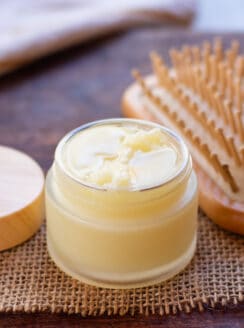
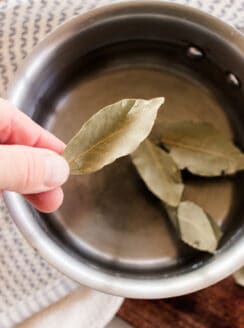
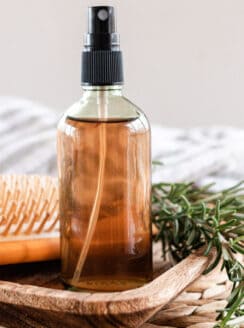
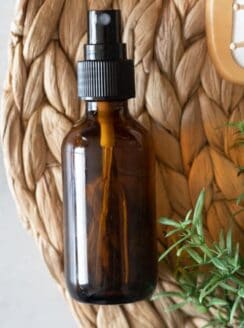
Linda says
I made rosemary olive oil as I have plenty of rosemary. How would that work?
Nicole says
I really want to try this recipe, may I ask what size mold to plan on for it?
Laura says
I have a link to the mold I used listed on the supplies 🙂
Anne says
Would there be a problem with using cold pressed shampoo bars with every wash? The PH of cold pressed soap is much higher than the scalp so I’m wondering if it would be ok? I’m debating between cold pressed shampoo bars and bars made without lye.
I’ve been reading about the high PH of cold pressed soap (ph of 8-9) which some say can be bad for the scalp (ph 5) and that it can damage the hair in the long run. I’m trying to figure out a shampoo bar for my daughters as regular shampoo is seeming to not work well for them.
Deborah says
I have been washing my hair with regular soap for several years now. You are right about the PH levels and the key is following it up with a vinegar rinse to help bring the PH level back down. Using soap without the vinegar rinse can leave hair feeling really bogged down and weird. But with the rinse you are left with clean, silky, soft and shiny hair. I find conditioner is not even needed. I use 1 part Apple Cider Vinegar or white distilled vinegar with 2 parts water, let that sit for a minute or two and then a brief rinse out to help alleviate any vinegary smell.
Diana says
My scale only has one digit after the decimal. The scale listed is the same. Will 4.4 ounces of lye and 9.8 ounces of distilled water work? Or should I use 9.9 ounces of distilled water.
I am looking forward to trying your recipe. Thank you for sharing it and any suggestions on the ingredient amounts.
Laura says
Yes, you should be able to round and it still work to that decimal.